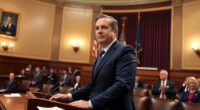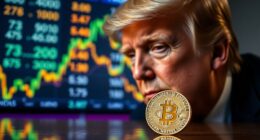You might have noticed Bitcoin's recent surge after the Federal Reserve meeting, especially following Jerome Powell's remarks on interest rates. While there was a brief dip post-announcement, the cryptocurrency has found stability above the crucial $100,000 mark. This shift in sentiment, coupled with dwindling exchange reserves, raises questions about what's next for Bitcoin. What other factors could influence its trajectory in the coming weeks?

As Bitcoin gains momentum following the recent Federal Reserve meeting, traders are closely monitoring its price dynamics, which are currently hovering around $102,000. After a slight dip of about 1% post-announcement, Bitcoin managed to maintain its position above the critical support level of $100,000. This price stability indicates a resilient market, especially given the resistance level at $105,000 that traders are eyeing.
Market sentiment is heavily influenced by the Federal Reserve's interest rate decisions. With rates held steady between 4.25% and 4.50%, Jerome Powell's comments during the press conference have become a focal point for investors. You can expect that any hints about future monetary policy changes could lead to significant price swings in Bitcoin and other risk assets. The cautious stance the Fed has taken suggests they're weighing inflation and labor market conditions carefully, which means that a sudden shift in these areas could impact Bitcoin's trajectory. Additionally, declining Bitcoin exchange reserves support the notion of scarcity, which often contributes to price increases.
One factor supporting Bitcoin's recent price gains is the decline in exchange reserves. As reserves dwindle, scarcity increases, which often translates into higher value for Bitcoin. This dynamic has led to a more bullish outlook among traders, especially as they assess global market reactions to the Fed's decisions. With overall economic indicators reflecting solid growth and low unemployment, the likelihood of immediate rate cuts seems low, further stabilizing the market.
However, caution is still the name of the game. In a climate where investors are wary of unexpected moves from the Fed, volatility remains a constant companion in the crypto space. The global crypto market cap even saw a slight decline as investors digested the Fed's positioning. You've got to be attentive to these shifts because they can impact your trading strategy significantly.
Adding to the complexity is the broader economic context, including political factors that could influence monetary policy. With Donald Trump back in the spotlight, his advocacy for lower borrowing costs could complicate the Fed's balancing act. Moreover, proposed tariffs on Mexico and Canada might create additional uncertainty in the markets, affecting Bitcoin's price dynamics.
Ultimately, as you navigate this landscape, keeping a close eye on both economic indicators and market sentiment is crucial for making informed trading decisions. The interplay between Bitcoin's price movements and the Federal Reserve's policies will continue to shape your trading strategies in the near future.









